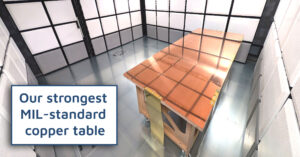
Exchanging Fast-stirring and ISO 11451-5 knowledge in Japan
Last week, our consultants, Hanneke van Veen and Dimitrios Barakos, visited seven companies in Japan with our friends from Microwave Factory to help companies implement the closed-loop power control (fast stirring) reverb method as per the ISO11451-5 test standards.



In this post, we explain why purchasing a test chamber that is not fully compliant can be very interesting. “It can save money and space,” says our technical advisor, Marc Le Roy. He explains how we helped the KU Leuven Brugge with an efficient and affordable solution.
Marc: “There is a difference between relevant and acceptable measurements. Take CISPR16-1-4, for example; to be fully compliant, you must have a chamber at least 5,5 meters high to perform a 4-meter height scan. Some of our clients do not have that height available; the additional information from the height scan is limited. In those cases, a pre-compliant chamber is almost just as effective because it still helps them test during the development stage of a product and be well-prepared for that final full-compliance test at an accredited test house. With your own chamber, you can considerably reduce the time-to-market. Imagine being able to test whatever you want, whenever you want—no more delays or travelling to external parties. Owning an in-house test chamber lets you control every aspect of testing. Especially for OEMs, this pre-compliant solution is attractive.”
Klaas Pluvier from the KU Leuven Brugge: ”Our pre-compliant lab in Brugge is a place where companies can perform tests during the development stage of products, such as computer peripherals, everyday mass-market electronics, and household appliances. The benefit for companies in this stage is that we are non-accredited as a test lab, so we are allowed to think with the client when a test does not meet the pass and fail criteria of the EMC standard and advise them, something accredited test houses are not allowed to do.”
Are you an OEM and want to invest in a pre-compliance chamber to shorten your time to market? Contact our technical consultant, Marc Le Roy.